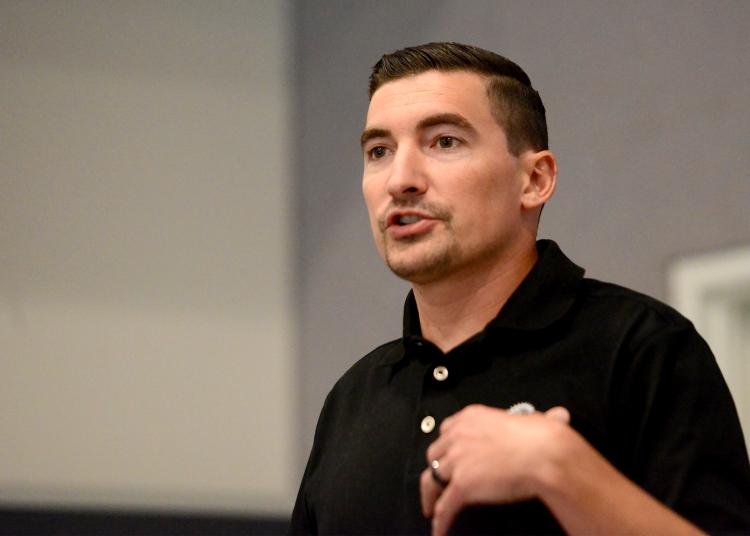After he lost his left hand during a 2004 training accident, Toshiro Carrington returned to active duty just three months later and remained one of the Navy SEAL’s top snipers.
But today, when he teaches others his skills, he can’t relate as well, using only one hand and a makeshift replacement for the other.

“Currently what I’m using is a hook that I designed,” he said, showing a metal hook that replaced his hand. “It’s pretty simple.”
What he needs, Carrington explained in a video, is a waterproof “hand” that’s lightweight and durable and would allow him to show his students how to load a weapon.
It doesn’t have to look like a hand, he said, just function like one.
“He wants to be able to show someone with two hands how it’s done,” said Lance Iunker, West Coast program manager for the Quality of Life Plus.
The program, now celebrating its tenth anniversary, detailed this year’s “challenges” for students looking for interdisciplinary senior design projects Tuesday. Founded by Cal Poly graduate Jon Monett, the lab challenges students to help wounded vets, first responders and law enforcement, often with prosthetic technology.

Jon Monett founded the QL+ Lab ten years ago.
After Monett launched the QL+ lab at Cal Poly, a dozen other schools nationwide added their own QL+ programs.
“This year we have 26 challengers who make up 35 projects,” Monett told the audience, which assembled at the ATL auditorium Tuesday.
Four challenges were presented, some of them via video, to the interdisciplinary students at Cal Poly. They were:
Tosh Carrington. In combat deployments, he was a team medic, point man, sniper and case officer. But in 2004, after returning from Iraq, he lost his hand in a training accident. He did four more deployments even after his injury, and two tours as a sniper instructor before retiring. Now he is president of Strategic Operations Training in San Diego, where he teaches law enforcement and civilians. For that role, he said, he needs a more functional prosthetic.
Jorge Segura. As a Marine, he was ambushed in 2010 by a Taliban soldier, whose rifle took 45 percent of his right arm. After undergoing 26 surgeries to try to salvage the limb, he had it amputated above the elbow – a decision he considers one of the best he’s ever made. But Segura loves to cook and hopes students will devise a prosthetic that will facilitate his culinary hobby.
Van Curaza. Known for surfing waves over 20 foot, Curaza founded Operation Surf in San Luis Obispo to help wounded vets heal physically and mentally through surf camps. While prosthetics usually help leg amputees stand straight and walk, they do not provide great balance for surfing, Caraza said in his video. “I have a pretty good idea of what works and what does not work,” he said. He challenged students to design a prosthetic that bends at the knee that will maximize amputee surfing experiences.
Craig Brady. In 2010, the Marine, from New Hampshire, lost his lower right leg from an improvised explosion device. Brady, who has excelled in sled hockey, loves to walk on the beach with his wife and children. But walking on sand with a prosthetic is difficult – and hurts his back. So he challenged students to devise a “sand foot” that is waterproof, stable in sand and comfortable.
Two other challenges were presented to mechanical engineering students:
Taylor Morris. After stepping on an IED while serving in Afghanistan in 2012, Morris lost all or parts of four limbs. The Navy vet, who has had Cal Poly students address previous challenges, has multiple trailers for different purposes. He is seeking a solution for easily changing the hitch for each trailer.
Danny Knutson. The former Navy fighter pilot and avid cyclist was struck by a hit-and-run driver nine years ago, rendering him an incomplete quadriplegic. He challenged students to devise a mounting system that would allow him to get in and out of his recumbent bike independently.
After hearing the presentations, students will be allowed to state their interest in working on the challenges. Then faculty will decide which ones are assigned to each. Monett, who managed a quick reaction lab during his career with the CIA, told students they would have to work quickly.
“So we’ll give you nine months, which was a long time for us,” he said. “But you’ve got to come up with a solution and build it and produce it and give it to the challenger.”


